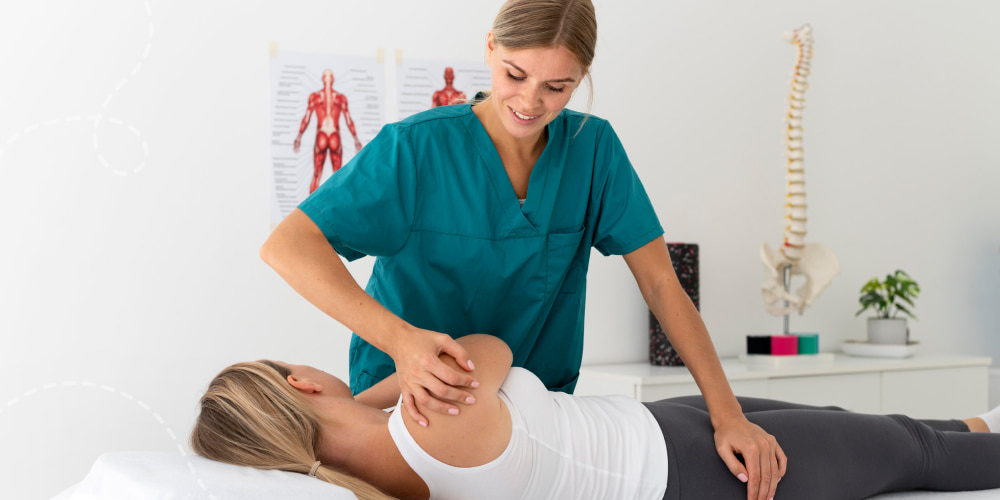An intervertebral hernia is often the reason for headache and hand insensitivity. It causes compression of the spinal nerve roots at their exit from the cervical disc; you feel pain and irritation or compression of the corresponding nerve fibers. As a rule, these changes are accompanied by muscle spasms, edema, inflammation, and impaired vascular circulation at this level.
The compression of the spinal nerves can cause dangerous complications, which leads to the loss of their function and the displacement of the vertebral hernia towards the spinal cord.
The incidence of cervical disc herniation is in second place after the lumbar spine.
Every fifth patient who goes to the doctor with complaints of neck pain suffers from this disease. The first signs are pain, discomfort, and a feeling of tightness in this part of the spine. Gradually, the intensity of pain increases, the following complaints appear:
- increasing headache, especially while turning the head
- instability of blood pressure
- frequent dizziness
- soreness.
The most vulnerable and weakest part is the area near the seventh vertebra, where there are many blood vessels.
The most common cause of pain in the neck, shoulder, and upper extremities is a herniated disc. Certain positions or neck turning can make the pain worse. In some patients, a herniated cervical disc can compress the spinal cord. Symptoms of spinal cord compression include:
- gait disturbance,
- difficulty performing accurate arm movements,
- insensitivity and tingling sensations in the body and legs,
- pelvic dysfunction.
Factors of Pathology Development, Symptoms and Treatment
Those who have a couch-potato lifestyle are likely to develop the disease; teachers, car drivers, office workers, and academic staff often complain of it.
Cervical herniated disc can be developed because of:
- metabolic disorders,
- lack of fluids,
- bad habits (smoking, drinking alcohol),
- heredity,
- the pathological processes in the spine (osteochondrosis, Schmorl’s hernia, and other degenerative changes),
- keeping the head down constantly,
- changes in the spinal column associated with human aging,
- sports injuries,
- overweight,
- congenital pathologies, on which the number and location of the vertebrae depend.
Symptoms of the Cervical Herniated Disc
It is possible to suspect a hernia of the spine when weakness and periodic attacks of numbness of the hands appear. Later, there is stiffness of the neck and limited movement up to the inability to tilt the head. The following symptoms also indicate the disease:
- frequent migraine-type headaches,
- increased fatigue,
- dizziness,
- body weakness,
- pain in the neck, aggravated by sudden movement.
As the disease progresses, there is a disruption in the functioning of the nervous system, manifested in a visual deterioration, constant head noises, and impaired coordination.
If you have some of these symptoms, then you should consult a specialist. Do not self-medicate; often, uncontrolled drug-taking only worsens the situation and causes inflammation. There is a risk of symptoms onset, but the consequences may be more threatening.
Treatment of a hernia
A doctor examines the patient; the necessary diagnostic methods are carried out to determine the tactics of treating a hernia.
For the treatment of cervical hernia, a wide range of medical procedures is used, including drug treatment, paravertebral blockade, traction, massage, spinal correction, physiotherapy, kinesitherapy, and physiotherapy exercises.
One of the new directions in the treatment of intervertebral hernias is the use of a shock-wave therapy apparatus specifically designed to treat spine diseases. The peculiarity of the use of this device is the dosed local impact of shock waves on the segments of the spine, controlled by the device’s sensors. At the same time, an improvement in blood supply at the site of exposure is achieved, tissue elasticity is restored, and muscle tension is eliminated.
How Does Disc Herniation Grow?
A healthy intervertebral disc consists of endplates, an annulus fibrosus, in the center of which is the nucleus pulposus – a very strong elastic formation that can withstand significant loads. Therefore, with a spinal injury, its fractures are more often observed than damage to the IVD.
Over the years, degenerative processes (nutritional disorders) develop. They start with the intervertebral disc and move to other elements of the spinal motion segment. It defines as osteochondrosis of the spine. It is a chronic, multifactorial recurrent disease; a genetic predisposition is observed in 80% of people. It is important to note that degeneration of the disc and its natural aging is the same process, but at different rates, complicated by the herniation. Early age-related deterioration of the spine expresses the lack of human biological perfection – as a tribute to nature for the transition to an upright position.
Initially, intradiscal changes (protrusion) of the IVD are observed, then the fibrous ring cannot withstand the load, and the nucleus pulposus ruptures it, forming a true IVD hernia (prolapse). Kernel drops can have different directions. When fragments of the nucleus fall into the epidural space of the spinal canal and often lead to disco-radicular conflict. In this case, the degenerative process spreads up and down to other IVDs and even parts of the spine – more often the lumbar (up to 30%), and less often the thoracic (less than 1%).
FAQ
- How to get rid of an intervertebral hernia without surgery?
The methods of non-surgical therapy include drug treatment, physiotherapy, exercise therapy, massage, manual therapy, kinesiotherapy, reflexology, traction of the cervical and lumbar spine.
- How should I sleep with a herniated disc in my neck?
If you have a herniated disc, the best sleeping position is lying on your back. In this position, your spine will be held in a neutral position, and thus, you will be less likely to pinch a nerve.
- Is a herniated disc in the neck serious?
It is a pretty serious disease; if you ignore the symptoms, it can have severe consequences. It may cause spinal cord compression in some patients; this is a more serious condition and may require more intense treatment.
- How long does the cervical herniated disc take to heal?
Many hernias disappear on their own. Research shows that the patient’s condition improves after 4-6 weeks, although symptoms may not go away for longer.











Please, leave your review
Write a comment: